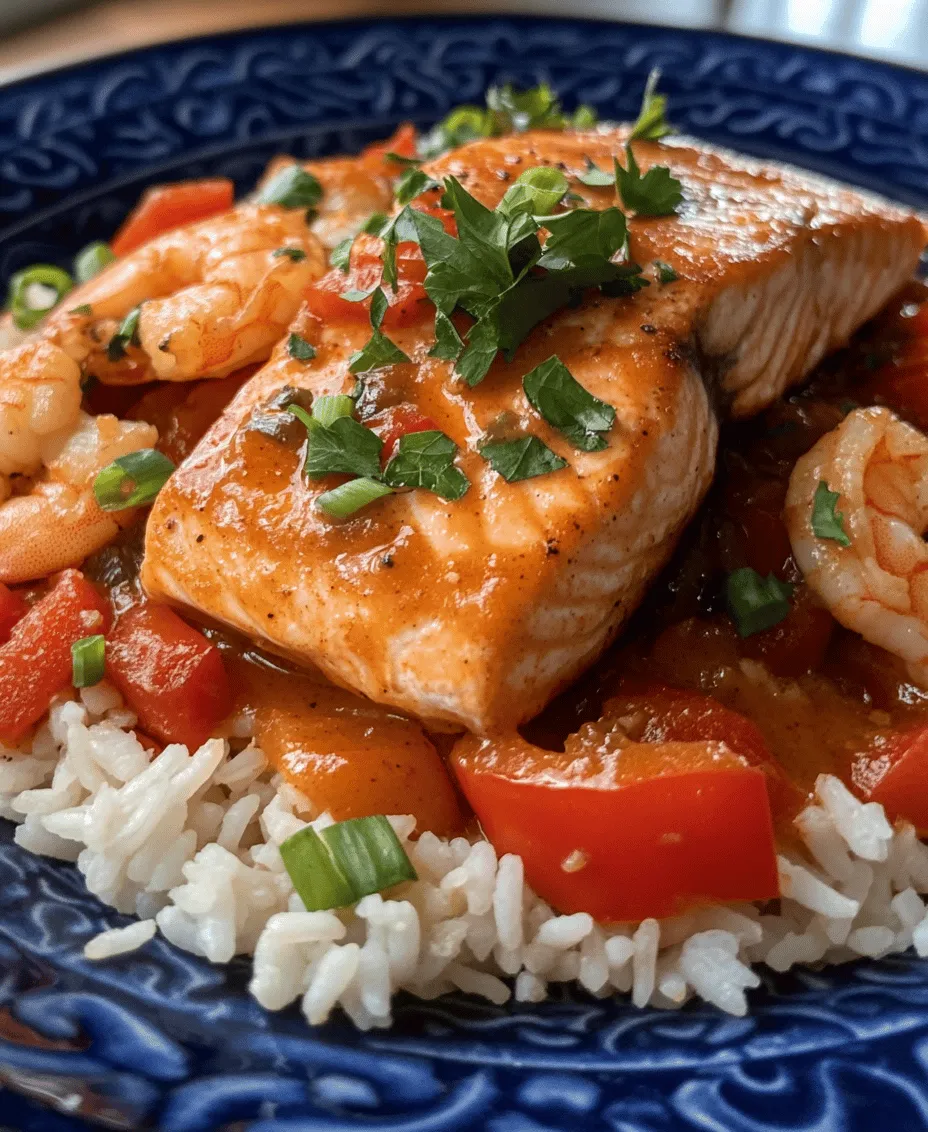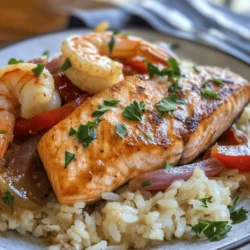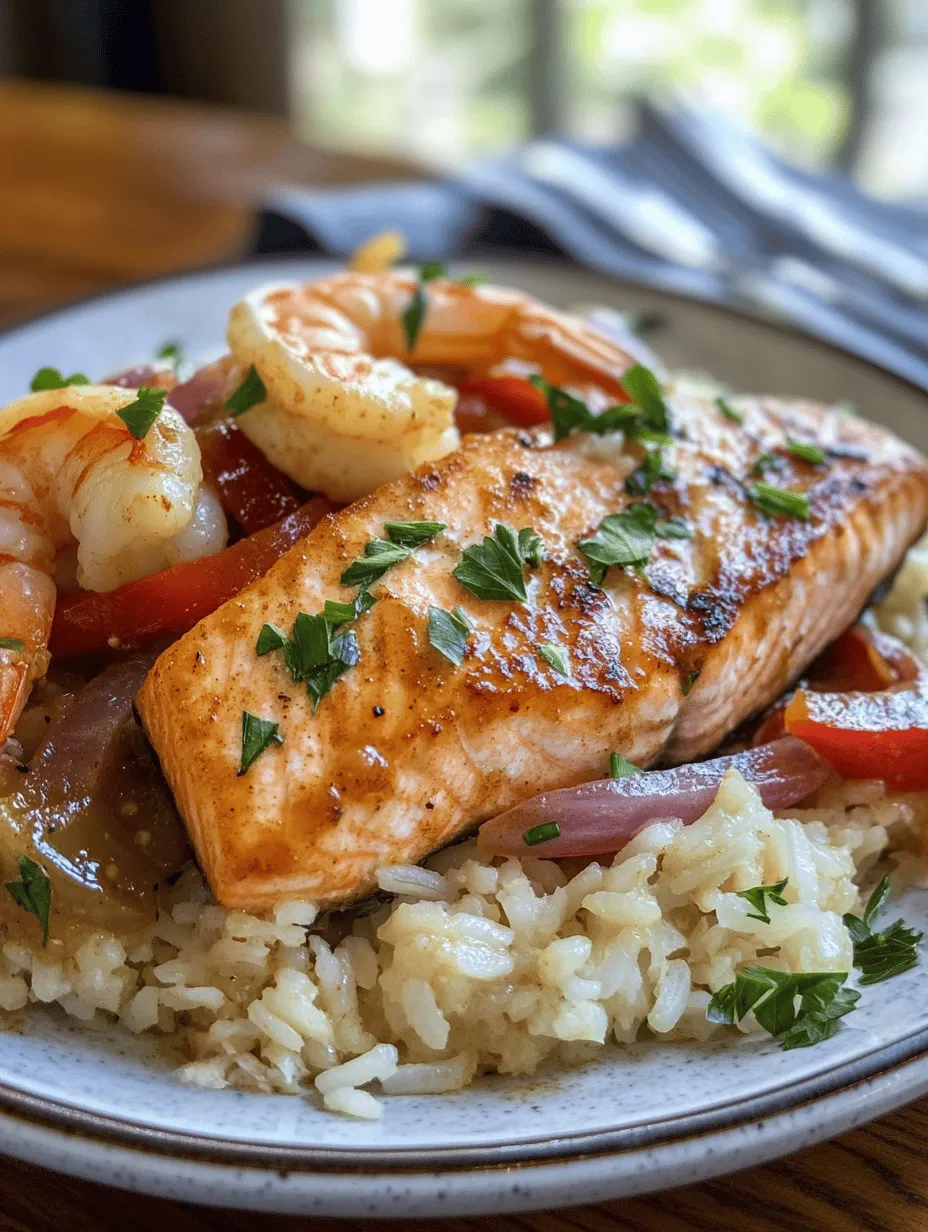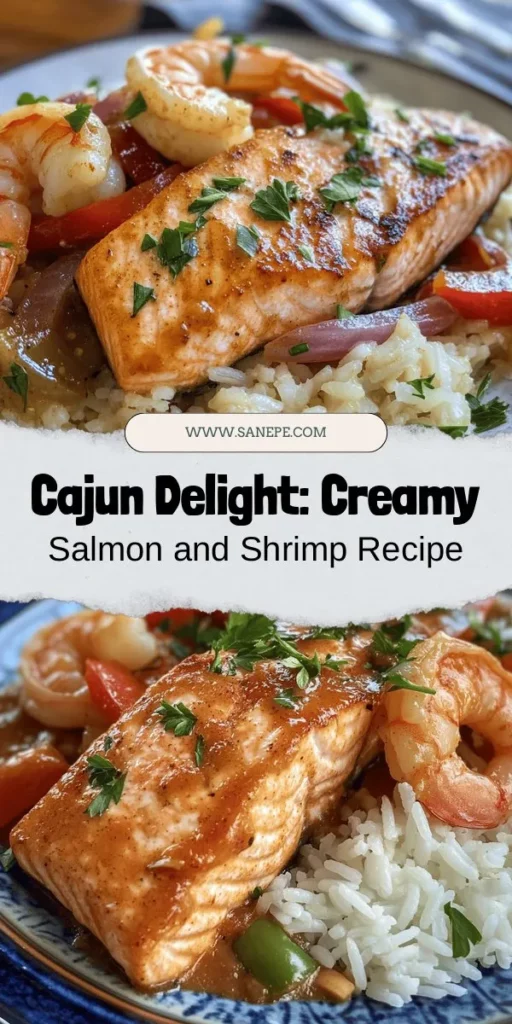Introduction
Cajun cuisine, with its rich blend of flavors and vibrant spices, is a celebration of culture and tradition that has its roots in the bayous of Louisiana. This culinary style, heavily influenced by French, African, and Native American cooking, is characterized by its use of bold spices, fresh seafood, and hearty ingredients. As you explore Cajun dishes, you’ll find that they not only tantalize the taste buds but also invite you to experience the warmth and hospitality of the South.
One standout recipe that embodies the essence of Cajun cooking is “Cajun Delight: Salmon and Shrimp in Creamy Sauce.” This dish features succulent salmon and tender shrimp, harmoniously combined in a luscious creamy sauce that’s infused with the signature flavors of Cajun spices. Whether you’re hosting a dinner party, preparing a special meal for your family, or simply indulging in a comfort food craving, this dish promises to impress with its quick preparation and delicious taste.
What makes this recipe particularly appealing is its versatility. It can be served over rice, pasta, or alongside crusty bread, making it a perfect choice for various occasions. Moreover, the combination of seafood and creamy sauce brings a luxurious feel to the dish, allowing you to enjoy a gourmet experience right at home.
Understanding Cajun Cuisine
To fully appreciate Cajun Delight, it’s essential to understand the roots of Cajun cuisine. Originating from the Acadian settlers who were exiled from Canada in the 18th century, Cajun cooking is a testament to resilience and adaptation. These settlers settled in Louisiana, where they incorporated local ingredients into their traditional recipes, creating a cuisine that is distinctly flavorful and hearty.
Cajun cooking is often defined by its use of a “holy trinity,” which consists of onions, bell peppers, and celery. This aromatic trio serves as the foundational flavor base in many dishes, much like mirepoix in French cooking. Alongside these staples, Cajun dishes frequently feature an array of spices such as cayenne pepper, paprika, thyme, and garlic, lending depth and character to the food.
Seafood holds a special place in Cajun recipes due to the region’s rich access to fresh fish and shellfish. From gumbo to jambalaya, seafood is often the star ingredient, celebrated for both its flavor and versatility. In this dish, we highlight two of the most beloved seafood options: salmon and shrimp, showcasing their individuality while also reveling in their complementary flavors.
Health Benefits of Salmon and Shrimp
When it comes to health and nutrition, both salmon and shrimp are excellent choices for a balanced diet. Salmon is renowned for its impressive nutritional profile, rich in omega-3 fatty acids, which are essential for heart health and brain function. Additionally, salmon is a great source of high-quality protein, vitamins B12 and D, and minerals such as selenium and potassium. These nutrients contribute to overall well-being, making it a powerhouse food choice.
On the other hand, shrimp is a low-calorie protein option that is also high in essential nutrients. A 3-ounce serving of shrimp contains about 20 grams of protein while being low in fat and calories, making it an ideal ingredient for those looking to maintain a healthy lifestyle. Furthermore, shrimp is rich in antioxidants like astaxanthin, which has been linked to numerous health benefits, including reduced inflammation and improved heart health.
Combining salmon and shrimp in one dish not only enhances the flavor profile but also amplifies the health benefits. The unique nutrients from both seafood sources work together to create a meal that is not only satisfying but also nourishing.
Ingredients Breakdown
To create this Cajun Delight, you will need the following ingredients, each playing a vital role in the overall flavor and texture of the dish:
1. Salmon Fillets: Fresh, skinless salmon fillets are the star of this recipe. Look for wild-caught or sustainably farmed salmon for the best flavor and health benefits.
2. Shrimp: Large, peeled, and deveined shrimp add a succulent texture to the dish. You can use fresh or frozen shrimp, but ensure they are properly thawed before cooking.
3. Cajun Seasoning: A robust blend of spices that includes paprika, cayenne pepper, garlic powder, and herbs. This seasoning is essential for achieving that signature Cajun flavor profile.
4. Olive Oil and Butter: A mixture of olive oil and butter is used for sautéing, imparting richness while allowing for high-heat cooking without burning.
5. Garlic, Onion, and Red Bell Pepper: These aromatics form the base of the sauce, adding depth and enhancing the flavor of the seafood.
6. Heavy Cream and Chicken Broth: The creamy sauce is made with heavy cream for richness and chicken broth for added flavor. This combination creates a luscious texture that envelops the seafood.
7. Garnishes: Fresh green onions and parsley add a burst of color and freshness, balancing the richness of the dish.
By gathering these ingredients, you’re well on your way to creating a delightful meal that captures the essence of Cajun cooking. In the next section, we will dive into the detailed steps to prepare this exquisite dish, ensuring that you can replicate it effortlessly in your own kitchen. Stay tuned for a culinary experience that tantalizes the senses and brings a taste of Louisiana to your table.

Serving Options: Rice or Pasta
When it comes to serving your Cajun Delight, the choice of accompaniment can elevate the dish to new heights. Both rice and pasta are excellent options that not only complement the flavors of the salmon and shrimp but also provide a satisfying base to soak up the creamy sauce.
Rice: White rice, brown rice, or even Cajun-style rice can create a hearty foundation for your seafood. The neutral flavor of rice allows the creamy sauce to shine, while the grains absorb the bold spices beautifully. For an added twist, consider making a Cajun rice pilaf by sautéing onions, bell peppers, and celery before adding your rice and broth.
Pasta: For a more Italian-inspired take, serve your Cajun Delight over al dente pasta. Fettuccine, linguine, or even penne can provide a perfect vehicle for the creamy sauce. The pasta’s texture will add an extra layer of indulgence, making it a luxurious dish that’s sure to impress.
Importance of Ingredient Quality for Best Results
The quality of your ingredients plays a crucial role in the success of your Cajun Delight. Fresh, high-quality seafood can significantly enhance the flavor and texture of your dish. When selecting your salmon and shrimp, look for:
– Salmon: Fresh, wild-caught salmon tends to have a richer flavor and firmer texture compared to farmed varieties. Check for bright, vibrant color and a clean ocean-like smell.
– Shrimp: Opt for shrimp that are large, fresh, and preferably shell-on for maximum flavor. If using frozen shrimp, ensure they are wild-caught and thawed properly before cooking.
Additionally, using high-quality spices can amplify the complexity of your dish. Authentic Cajun seasoning blends often include paprika, cayenne, garlic powder, and thyme. Opt for freshly ground spices when possible, as they provide a more robust flavor.
Step-by-Step Cooking Instructions
Seasoning the Seafood: Importance of Flavor Infusion
Start by seasoning your seafood generously with your chosen Cajun seasoning. This step is crucial as it ensures that the flavors penetrate the fish and shrimp, enhancing their natural taste. For optimal results, allow the seafood to marinate for about 15-30 minutes. This will not only infuse flavor but also help tenderize the shrimp, making it succulent.
Searing the Salmon: Techniques for Achieving the Perfect Crust
To achieve a perfectly seared salmon fillet, follow these steps:
1. Preheat a skillet over medium-high heat and add a tablespoon of olive oil or butter.
2. Once the oil is shimmering, carefully place the salmon skin-side down. Press gently to ensure even contact with the pan.
3. Do not move the salmon for the first few minutes; this allows it to develop a crispy crust. Cook for about 4-5 minutes or until the edges begin to turn opaque.
4. Flip the salmon carefully and cook for another 3-4 minutes, depending on the thickness of the fillet. The salmon should be golden brown on the outside and slightly pink in the center.
Achieving that perfect crust requires patience and a little finesse, but the resulting flavor and texture are well worth the effort.
Cooking the Shrimp: Timing and Visual Cues for Doneness
Shrimp cook very quickly, so timing is key. After removing the salmon from the pan, add your seasoned shrimp directly to the same skillet.
1. Cook the shrimp for approximately 2-3 minutes on one side without moving them. You want to see a pink hue developing on the edges.
2. Flip the shrimp and cook for another 1-2 minutes until they turn opaque and form a slight curl. Be careful not to overcook, as this can lead to a rubbery texture.
Sautéing the Vegetables: Enhancing Flavor Through Proper Cooking Methods
Once the shrimp are cooked, remove them from the pan and set aside. In the same skillet, add diced onions, bell peppers, and minced garlic.
1. Sauté the vegetables for about 3-4 minutes until they become soft and aromatic.
2. Scrape the bottom of the pan to incorporate any flavorful bits left behind from the seafood. This will add depth to your sauce.
This step is essential as it builds a flavor base that enhances the overall taste of the dish.
Creating the Creamy Sauce: Tips for Achieving the Right Consistency
After sautéing the vegetables, it’s time to create the creamy sauce.
1. Pour in heavy cream (or a dairy alternative for a lighter version) and bring it to a gentle simmer.
2. Stir in additional Cajun seasoning and a splash of lemon juice for brightness.
3. Allow the sauce to cook for a few minutes, stirring frequently until it thickens slightly. If the sauce becomes too thick, you can always add a splash of broth or water to achieve your desired consistency.
The creamy sauce should coat the back of a spoon and have a luscious texture that complements the seafood perfectly.
Combining Seafood with Sauce: Ensuring Even Coating and Flavor Distribution
Once your sauce has reached the desired consistency, return the cooked salmon and shrimp to the skillet.
1. Gently toss the seafood in the sauce, ensuring an even coating. This step allows the seafood to absorb the creamy, flavorful sauce.
2. Let everything simmer together for an additional minute, allowing the flavors to meld.
This careful combination enhances the richness of the dish and allows each bite to be packed with flavor.
Serving Suggestions: Presentation Tips for a Visually Appealing Dish
Presentation can elevate your meal from ordinary to extraordinary. Here are some tips for serving Cajun Delight:
– Plating: Use a large shallow bowl or a wide plate to create an appealing backdrop for your dish.
– Layering: Start with a base of rice or pasta, then gently arrange the salmon and shrimp on top. Drizzle the creamy sauce over the seafood, allowing it to pool around the base.
– Garnishing: Finish with a sprinkle of fresh parsley or green onions for a pop of color. A wedge of lemon on the side can also add a fresh touch.
This thoughtful presentation will impress your guests and make the meal feel even more special.
Flavor Enhancements
While the original recipe is delicious on its own, you can explore variations to cater to your personal taste and dietary preferences.
Exploring Variations of Cajun Seasoning
Cajun seasoning can vary significantly from one brand to another. To customize the flavor profile of your dish, experiment with different blends or create your own by combining paprika, cayenne, onion powder, garlic powder, thyme, and oregano. You can adjust the heat level by adding more or less cayenne pepper to suit your palate.
Alternative Ingredients for Dietary Preferences
For those following a dairy-free diet, consider using coconut cream or cashew cream as a substitute for heavy cream. These alternatives will still provide a creamy texture while introducing a unique flavor that complements the Cajun spices.
Additionally, if you’re looking to reduce carbohydrates, serve your Cajun Delight over spiralized zucchini or cauliflower rice instead of traditional rice or pasta.
Suggestions for Adding Extra Vegetables or Spices for Customization
Feel free to incorporate more vegetables into your Cajun Delight. Spinach, mushrooms, or asparagus can be sautéed along with the other vegetables for added nutrition and flavor. You can also introduce spices like smoked paprika or crushed red pepper flakes to enhance the dish’s complexity.
Pairing Suggestions
The right side dishes and beverages can elevate your Cajun Delight experience.
Ideal Side Dishes that Complement Cajun Delight
Alongside your main dish, consider serving a light salad dressed with a citrus vinaigrette to balance the richness of the creamy sauce. Cornbread or a crusty baguette can also be delightful options for soaking up the sauce.
Beverage Pairings: Wines and Cocktails that Enhance the Dining Experience
When it comes to beverage pairings, a chilled white wine such as Sauvignon Blanc or Chardonnay works beautifully with seafood. If you prefer cocktails, a zesty mojito or a classic gin and tonic can refresh your palate between bites.
Cultural Aspects of Meal Pairing in Cajun Cuisine
Cajun cuisine celebrates bold flavors and communal dining, making it a perfect opportunity to share with friends and family. Pairing your meal with traditional Louisiana beverages like sweet tea or a local craft beer can enhance the cultural experience of your Cajun Delight.
Conclusion
Cajun Delight: Salmon and Shrimp in Creamy Sauce is a dish that encapsulates the vibrant flavors and rich culinary traditions of Cajun cuisine. With its combination of succulent seafood, a hearty creamy sauce, and the option to serve over rice or pasta, this recipe offers both indulgence and satisfaction.
Not only is this dish a feast for the senses, but it also provides health benefits from the omega-3 fatty acids found in salmon and the lean protein from shrimp. The ease of preparation makes it an ideal choice for both weeknight dinners and special occasions.
We encourage you to explore Cajun cooking further, experimenting with this recipe and making it your own. Cooking is a joyful journey, and sharing flavorful meals with loved ones can create lasting memories. Dive into the world of Cajun cuisine, and let your kitchen be filled with the enticing aromas and vibrant flavors of this delicious dish.


